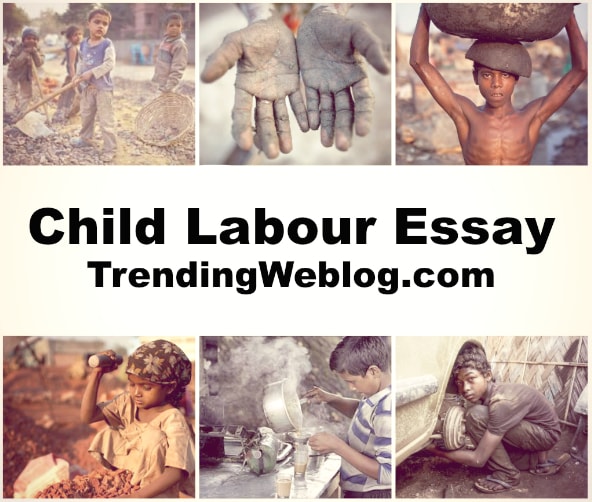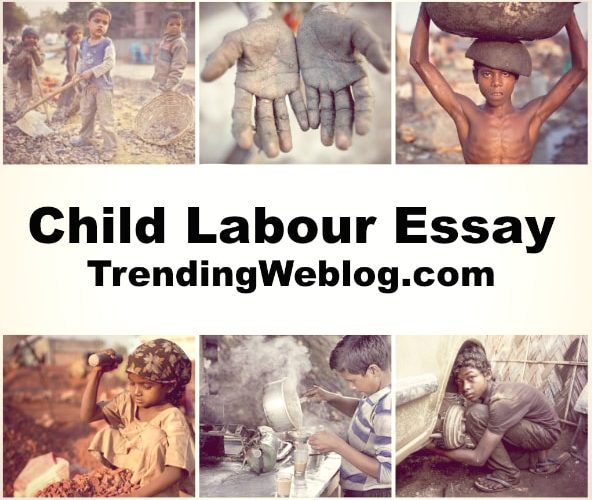Child Labour Essay – Child Labour Essay for Class 5, 6, 7, 8, 9, 10, 11 and 12. Find paragraph, long and short essay on Child Labour for Students.
Child Labour Essay in English for School Students

Essay on Child Labour in English
Child Labour Essay 300 Words
Child Labour is a major problem in India. It has been an international concern because it damages, spoils and destroys the future of children. It is poverty that forces a child to earn money to support his family. Though it is prevalent in the whole of the country, the problem is acute in socio-economically weaker State like UP, Bihar, Orissa, Jharkhand, Chhattisgarh, Madhya Pradesh, and the North Eastern States. Besides poverty, lack of education, and accessible sources of credit forces poor parents to engage their children as child labour. The big challenge for India, as a developing country is to provide nutrition, education, and healthcare to these children.
Child Labour is a great socio-economic problem. Child Labour is, in fact, a source of income for poor families. Children essentially work to maintain the economic level of households, either in the form of work of wages, or help in household enterprises or in household chores. In all the activities the basic objective is to provide the family with financial support. In some cases, it has been found that a child’s income accounted for between 34 and 37 percent of the total household income. A child labour’s income is important to the livelihood of a poor family.
The law in Indian soil says that any child below the age of 14 cannot be employed either in a factory or office or restaurant. Truly speaking child labour is frequently utilized in India in various places of production and service e.g., small-scale industry, restaurant service, domestic aid, shopkeeper’s assistant, stone breaking, bookbinding, in fact in every household industry.
The solution to the problem of Child Labour are: The child labor laws need to be strictly enforced by the Government. The government should ensure that every child gets the opportunity to go to school.
Child Labour Essay 500 Words
Child Labour is the practice where children engage in economic activity, part or full-time basis. This practice deprives children of their childhood and is harmful to their physical and mental development.
The Constitution of India in the Fundamental Rights and Directive Principals of State Policy prohibits child labour below the age of 14 years. India is, very sadly, home to the largest number of child labours in the world. The government of India has recently ratified the International Labour Organisation (ILO) Convention 182 on the worst forms of child labour and Convention 138 on Minimum age of employment. About 4.3 million children wake up to a day of labour and not to school and 9.8 million are officially out of school.
Worst forms of child labour
Child slavery (including the sale and trafficking of children, debt bondage, and forced recruitment for armed conflict), child prostitution and their use in pornography, use of children for illicit activities such as drug trafficking, and exposure to any hazardous work which is likely to harm the health, safety or morals of children.
Causes responsible for Child Labour
Poverty, lack of Social Security net, lack of proper education, no real and meaningful alternative, the growth of the low paying informal economy – India has rigid labour laws and numerous regulations that prevent the growth of the organized sector, girls are most deprived and underprivileged of the whole class of such children.
Consequences of Child Labour
Children who work fail to get the necessary education. They do not get the opportunity to develop physically, intellectually, emotionally and psychologically. Skill development is difficult to achieve in such a case and as a result quality of HUMAN CAPITAL is low. They are treated badly at times and harassed emotionally and even physically. This undermines their potential and at times turns them into future criminals.
Initiatives
Gurupadswamy committee was constituted in 1979 to find about child labour and means to tackle it. As per its recommendations, the Child Labour (Prohibition & Regulation) Act was enacted in 1986. The Act prohibits employment of children in certain specified hazardous occupations and processes and regulates the working conditions in others. The list of hazardous occupations and processes is progressively being expanded on the recommendation of Child Labour Technical Advisory Committee constituted under the Act. In consonance with the above approach, a National Policy on Child Labour was formulated in 1987.
Parliament passed Child Labour (Prohibition and Regulation) Amendment Bill, 2016 which prohibits the employment of children up to 14 years of age, and prohibits children up to 18 years of age in hazardous occupations.
For example – hazardous occupations like mines, inflammable substances, explosives and fireworks.
Conclusion
The problem of child labour continues to pose a challenge before the nation. Considering the magnitude and extent of the problem and that it is essentially a socio-economic problem inextricably linked to poverty and illiteracy, it requires concerted efforts from all sections of the society to make a dent in the problem.







